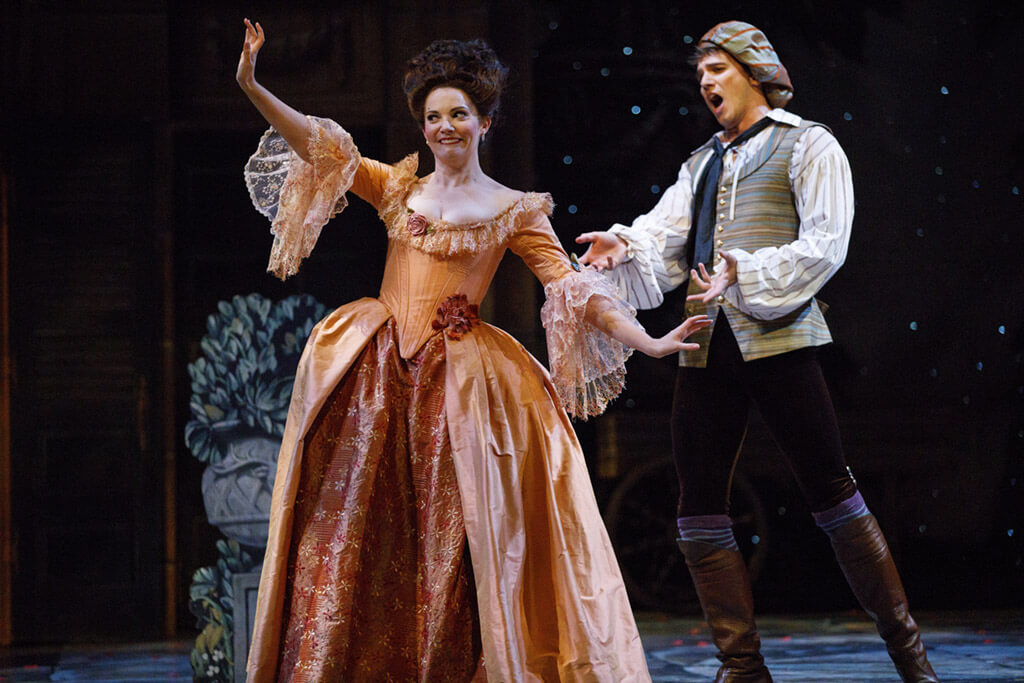
Opera Atelier: The Marriage of Figaro. At the Elgin Theatre, Oct. 26 through Nov. 4. Visit operaatelier.com for details.
It isn’t often we get to see a Marriage of Figaro like Opera Atelier’s successful opening three shows this past weekend, one so polished and sleek, full of vivacious fun and artistic verve.
Here we have the perfect Figaro — supremely sung, breathtakingly danced and with spot-on acting.
And all of it was done without the faintest pretence to the modernization of Mozart’s classic, a comic theatre piece no less and a pure opera buffa so ravingly popular with the public and composers that it completely changed the musical landscape with its powerful influence. No one who composed an opera thereafter could ignore Mozart’s masterpiece, especially the innovative Act II finale that proved to be a structurally dramatic game-changer.
Here are ten reasons why you need to buy a ticket this week to see any one of the remaining shows in Opera Atelier’s highly convincing, successful production.
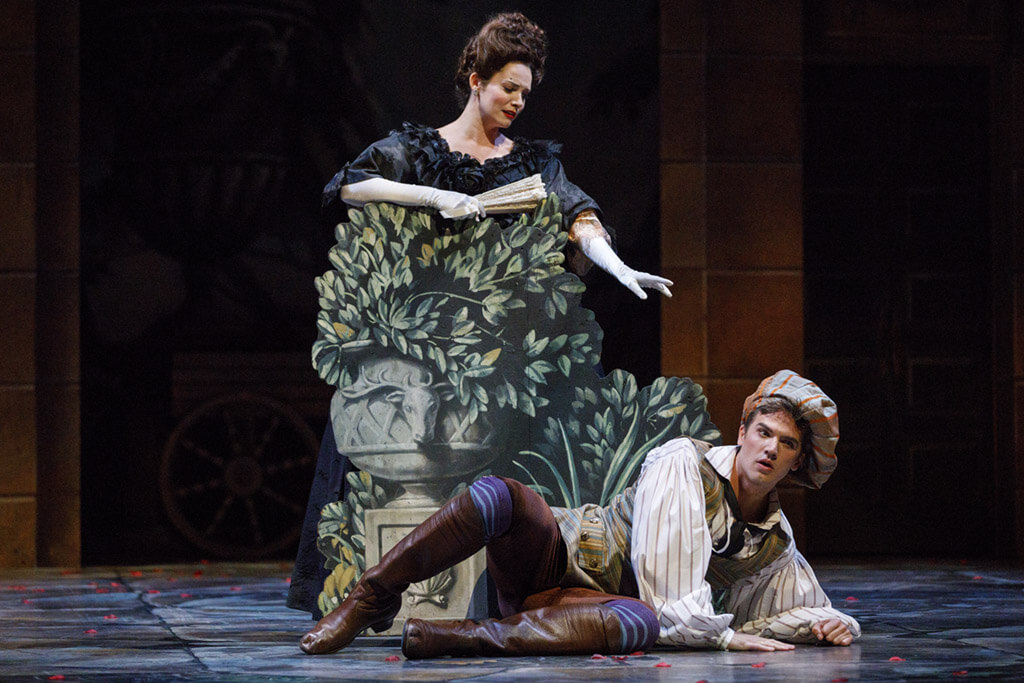
1/. Singing: It’s all good. Douglas Williams is a lithe, kinetic Figaro who seems to throw his whole lanky frame into his vocal signature. He has a great voice, superb acting skills and is a convincing foil for an equally eloquent Stephen Hegedus as Count Almaviva. Hegedus gives the role the three-dimensional balance between misguided philanderer and unsympathetic domineeringness that doesn’t take us directly to the Dark Side, like so many productions do these days. Both baritones are equal in vocal weight and lyricism, flexibility and humanity and on-stage presence.
The women are splendid too. Mireille Asselin (Susanna), Peggy Kriha Dye (Countess Almaviva), and Mireille Lebel (Cherubino) offer diverse and varying performances, each bringing a masterful understanding of their roles and the needed vocal character to blend both dramatic and comic action. Audiences warmed to all performers, and nothing was uneven.
Ensembles were like gold. A superb marital spat scene between Hegedus and Kriha Dye (trio, then duo) forms a lengthy highlight centrepiece of Act II. The ensemble revelation scene of Figaro’s origins and true parentage in Act III was compactly focused, nicely harmonically tuned, tonally nuanced, blended and phrased beyond mere four-square predictability, and very often exhilarating.
2/. Dramatic Action: …..obeyed every eighteenth-century dramatic archetype from character to costume, convention to commedia dell’arte. Never before have I taken in a Figaro that actually made complete dramatic sense along the way, intimately tying the libretto (entirely translated into English), in which the music was subservient to the theatrical norms and dramatic body gestures of the time. Best of all, the libretto’s rampant insouciance and periodic farce laced with innuendo was never too much in your face, except for Christopher Enns’ supremely slimeball Basilio. Enns has the perfect voice, filled with long-scooped onsets and slithering meander suited to the commedia dell’arte snake the role demands.
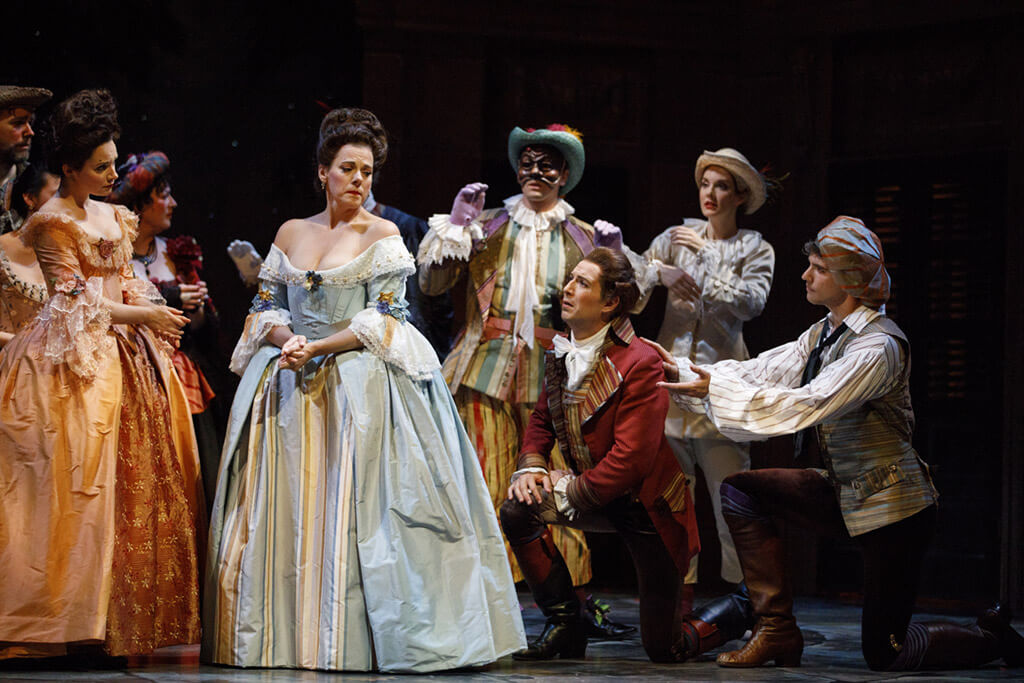
3/. Direction: To this end, Marshall Pynkoski’s direction was remarkable. Every scene felt fleshed out to its fullest extent. Pynkoski puts you directly in touch with 18th-Century comedy, specifically Viennese-flavoured theatre of Mozart’s time, and as a result, I learned more from this Figaro than the many others I have seen on multiple stages in the past twenty years. Marriage of Figaro needs to live and breathe as a well-researched, staged buffa and not merely as a monolithic operatic icon. Pynkoski brings the stage to life with his customary attention to a thousand details and blends it seamlessly with the music lending Mozart’s melodies and harmonies new clarity. Now that, by its original intention, is what opera is supposed to be.
4/. It’s in English: Yes, you read that correctly above. The opera’s original libretto by Lorenzo da Ponte is translated and partly ‘transladapted’ by Jeremy Sams. The new English text injects a little bit of British Music Hall sensibility with a penchant for witty rhyming word play and sardonic insult. In Italian comedy, the wit was grounded more on troping the conventional meaning of words to the unexpected punch-line, whereas the French thrived on parrying point-counterpoint. Some of these qualities are deleted when da Ponte is mildly transladapted here, but the trade-off is worth it to explain the twists and turns in Marriage of Figaro’s contorted plotline, especially in Act IV.
All this serves Pynkoski’s highly physical direction acutely well. The action is crisp and the show never drags. However with some of the finer Italian moments absent, I’m not the only one to confess that the poetic naturalness of the footfalls that accorded well with Mozart’s melismatic lyricism and rapid parlando byplay make me long for the original. Moreover, Peggy Kriha Dye’s “Dove sono” sounds much harder to sing and demands a different, somewhat more strenuous phrasing and breath placement with the English translation. I admired how well she brought it off in Saturday night’s performance (and “Porgi Amor” too) coping very well with a less natural text placement. Finally, Cherubino’s Act I aria “Non so più” was slower in tempo to accommodate the English text, but Mireille Asselin gave it such tremendous diction and beauty, I tended to readily accept the adaptation thanks to her sterling voice and musicianship.
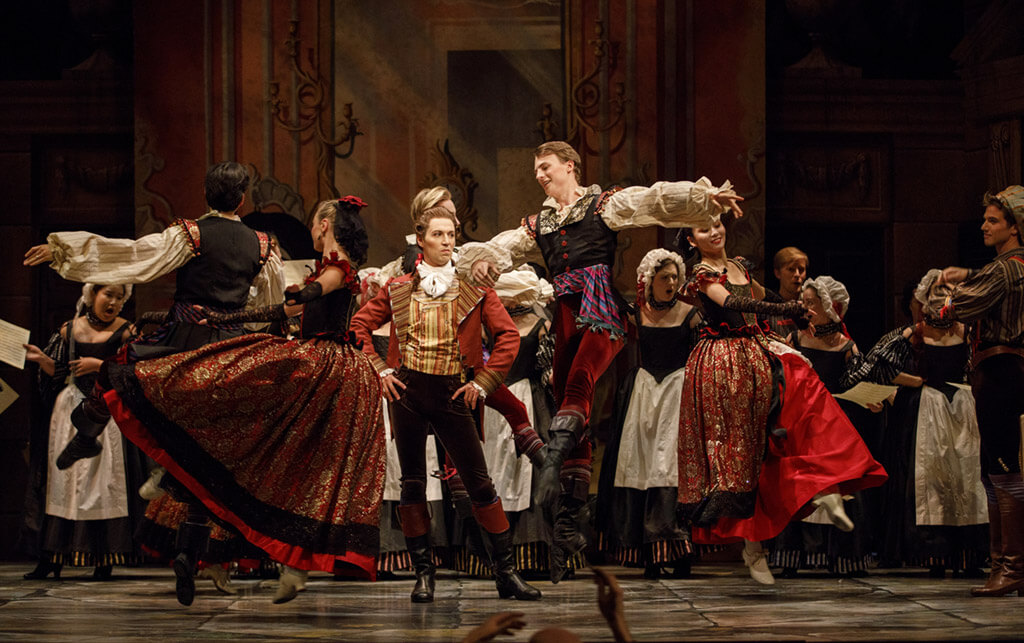
5/. Comic Kinetics: This is a very physical Figaro for both the title role and the somewhat broadly-stroked commedia characterizations of every cast member — and it paid dividends. Pynkoski’s great direction leaves no corner of the stage unused, no dramatic/comic possibility unexplored. This allows the plot to reveal more than it typically does in other productions allowing us to appreciate Mozart’s music even more.
Furthermore in the eighteenth century, when comedy began to be censured for its ‘debauchery’, there was a growing expectation for commedia dell’arte characters to become more coquettish and discreet. Actors then increased hidden textual meanings through their physicality. For example, in the Opera Atelier production, the clothing change and cross-dress scenes written for Cherubino in Act II were funnier, subtler and more meaningful in conveying disguised attractions. Pynkoski’s approach brought a greater directorial sensitivity to how these moments could be physically played and how their ensuing implications for revealing relationships between the women could likewise expose us to greater musical-dramatic depth.
6/. Costumes: Masks, commedia dell’arte colours, capes, dresses, coats, hats, all of it by Dora Award-winning costume designer Martha Mann fit the character to the archetypal role so appropriately and without carnivalesque exaggeration that I felt comfortable with each onstage personality. We all knew who they were and what dramatic purpose they were supposed to serve. Mann’s costumes were entirely a refreshing departure from the garish attempts at caricature we often see in other productions.
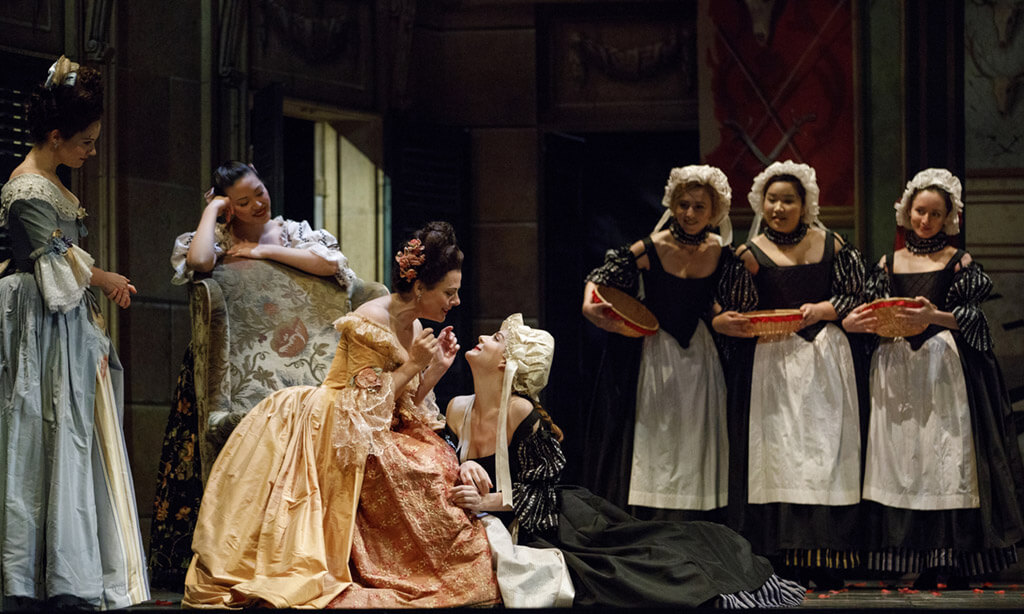
7/: Acting: Direction, costumes and an inordinate amount of blocking and activity just seemed to bring out the best acting possible from the entire cast. Approaching the audience in ensemble codas to sing to us in theatrical tradition drew us in. The acting was intimate and never hammy, flecked with camp but never too much. Everyone struck the right balance.
8/: Orchestra: Finally I understand the overture and its comical, nervous giggles and fidgety figurations. They were clearly meant to imitate the intensely physical theatre of the time. Conductor David Fallis slowed only a few tempi, primarily to accommodate the English translation or so it seemed. Largely, Fallis’s scholarship and understanding of the score is utterly unerring. The orchestra was clean and polished, impressive in stylistic nuance and blend, expressive where needed but above all, well calculated for the theatre space in which they played. They sounded superb from the back of the orchestra-level seats.
9/: Relevance: In an age that witnesses the ever-growing calling-out of high-powered men for their uncouth behaviour and sexual harassment, these performances made one marvel at how an opera more than two hundred years old can tell the perfect tale of the Count Almavivas of today. Without trying too hard, a strong physical theatre performance made me feel like I was watching the perfect mirror held up to contemporary times.
10/: Dancing as Aesthetic and Metaphor: Near the beginning of Act I, when Figaro finds out that his master the Count Almaviva secretly wishes to revive the arcane Droit de Seigneur (Right of the First Night), in order to seduce Figaro’s bride Susana away from him, Figaro sings the famous cavatina “Se vuol ballare” — “If you want to dance I shall call the tune.” By equipping dance with so powerful a metaphorical impact to describe the opera’s themes of social and political upheaval, Mozart sets his comic revenge-piece in motion using Beaumarchais’ theatrical chaos and comic contortions to effectively show how Figaro, the true intellectual master, outsmarts the Count, in effect cutting through a caste society.
Opera Atelier somewhat restored the importance of the metaphorical device that dancing and theatre confer to the opera, as we believe Mozart has always wanted. Dancing in Marriage of Figaro was not mere bauble but well-positioned, plot-driven ballata. (Mozart once stated he loved dance even more than music).
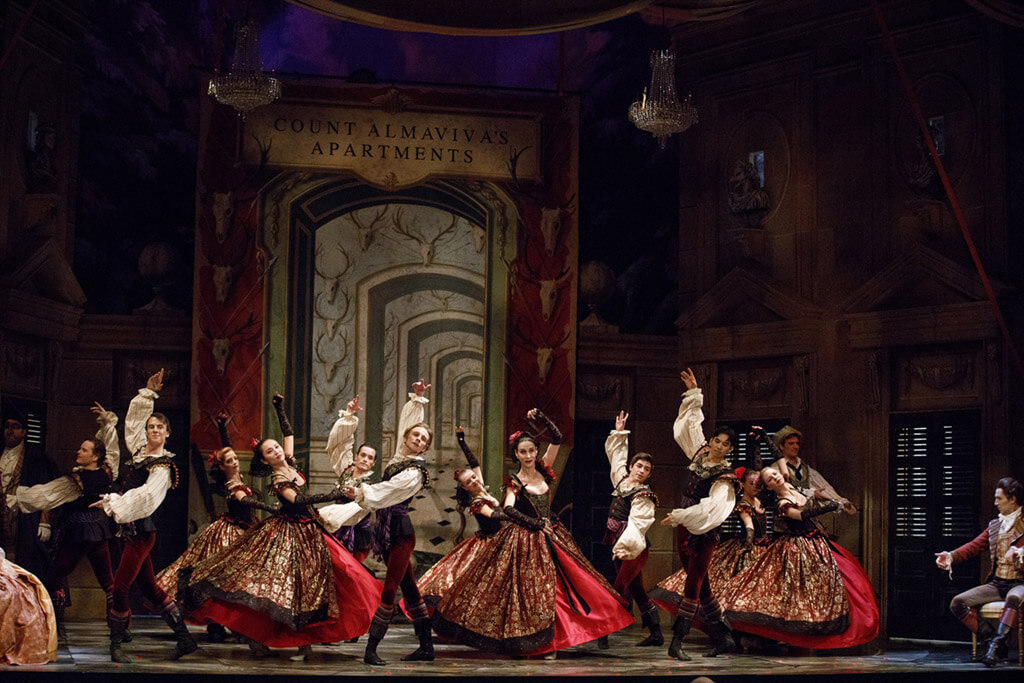
To dance, in this context, equated to social manoeuvring, plotting, parrying and thrusting, and moreover, duelling between a master and a servant engaged in a battle of wits, which was a highly controversial subject for its time. When Beaumarchais wrote his pre-Revolutionary French play on which Lorenzo da Ponte would carefully redact a libretto that wouldn’t arouse too much criticism from Viennese censors, the gunrunner/playwright/revolutionary used the name Figaro, based on the the French verb “figurer” as in “figuring out” — a skill the opera’s title character is supposed to possess in abundance. The same word in both French — and by co-incidence its Italian cognate “figurata” — both mean dancer.
Figaro the dancer, is also Figaro the highly kinetic buffo baritone, a brand new invention by Mozart for a comic lead. Dance Master and co-artistic director Jeannette Lajeunesse Zingg and director Pynkoski have likewise restored the Figaro character as well to something more like Mozart’s original buffo intentions.
While true that we can see this in a few other productions (many of which I have taken in live and on blu ray), it’s Opera Atelier’s pronounced success at restoring the opera’s required commedia dell’arte theatricality and Douglas Williams’ comically seamless Figaro that lead the way.
Opera Atelier’s Marriage of Figaro must be seen if you want to truly understand how much this opera meant to people over two hundred years ago, and how much it still means to us today.
Post-Script: The Fandango Scene — some extra, but important notes
Douglas Williams was perfectly timed in the Act III fandango finale, where he and Mireille Asselin’s Susanna must manoeuvre through the dancers, splendidly attired in perfect historical costume and with exact arm motions, complete with compulsory castanets for an aristocratic triple-metre dance.
Earlier in the eighteenth century, according to French and Spanish writers, the fandango was a duple-metre dance in 6/8, but by Mozart’s time, the fandango had evolved into a highly popular, triple metre couple’s dance for the aristocracy — less sensual, with its original erotic intents disguised for the more demure royalty.
In the famous Act III message scene, where Susanna slips the Count a note requesting a late-night garden rendez-vous (it’s a trap of course, designed to humiliate the Count in front of the long-suffering Contessa Rosina, who exchanges cloaks with Susanna), there is a small passage of about ten bars in the score where Mozart writes “Figaro dances” but, in a couple’s dance, with whom?
Opera Atelier gets this scene just right. Pynkoski and Lajeunesse Zingg have Figaro and Susanna manoeuvre through the fandango corps, quite comically and unexpectedly, so that Susanna can give the Count the assignation note without him realizing that the lovers are scrutinizing his reaction. The Count himself is distracted during this subterfuge, and while opening the note is pricked by the pin which seals it. The pricking moment, while Figaro and Susanna move seemingly unnoticed throughout the fandango, was a delicious, dance/dramatic symbol that other productions nearly always miss. The implication of the fandango, as left to us to decipher from Mozart’s score directions, seems to be that Figaro dances as much with his bride-to-be in this production as he does symbolically with his master, who is yet again to be outsmarted — pricked by Figaro’s wit. Truly when Figaro dances, he calls the Count’s tune.
![]()
- SCRUTINY | Opera Atelier’s Film Of Handel’s ‘The Resurrection’ A Stylish And Dramatic Triumph - May 28, 2021
- HOT TAKE | James Ehnes And Stewart Goodyear Set The Virtual Standard For Beethoven 250 - December 15, 2020
- SCRUTINY | Against the Grain’s ‘Messiah/Complex’ Finds A Radical Strength - December 14, 2020



